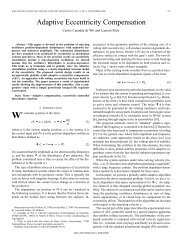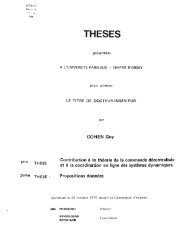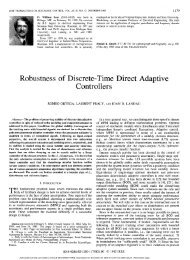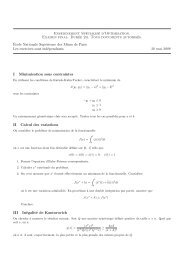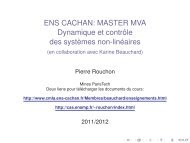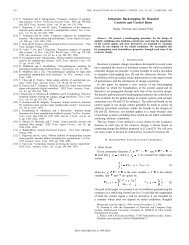HOMOGENEOUS OBSERVER DESIGN 1819then the function Φ i (x) = ∫ x iφ(x0 1 ,...,x i−1 , s, x i+1 ,...,x n ) ds <strong>is</strong> homogeneous inthe 0- (resp., ∞-) limit with associated triple (r 0 ,d 0 + r 0,i , Φ i,0 ) (resp., (r ∞ ,d ∞ +r ∞,i , Φ i,∞ )), with Φ i,0 (x) = ∫ x iφ0 0 (x 1 ,...,x i−1 , s, x i+1 ,...,x n ) ds (resp., Φ i,∞ (x) =∫ xiφ0 ∞ (x 1 ,...,x i−1 , s, x i+1 ,...,x n ) ds).By exploiting the definition <strong>of</strong> homogeneity in the bi-limit, it <strong>is</strong> possible to establ<strong>is</strong>hresults which are straightforward extensions <strong>of</strong> well-known results based on thestandard notion <strong>of</strong> homogeneity. These results are given as corollaries <strong>of</strong> the followingkey technical lemma, the pro<strong>of</strong> <strong>of</strong> which <strong>is</strong> given in Appendix C.Lemma 2.13 (key technical lemma). Let η : R n → R and γ : R n → R + be tw<strong>of</strong>unctions homogeneous in the bi-limit, with weights r 0 and r ∞ , degrees d 0 and d ∞ ,and approximating functions, η 0 , η ∞ and γ 0 , γ ∞ such that the following hold:{ x ∈ R n \{0} : γ(x) =0} ⊆{ x ∈ R n : η(x) < 0 } ,{ x ∈ R n \{0} : γ 0 (x) =0} ⊆{ x ∈ R n : η 0 (x) < 0 } ,{ x ∈ R n \{0} : γ ∞ (x) =0} ⊆{ x ∈ R n : η ∞ (x) < 0 } .Then there ex<strong>is</strong>ts a real number c ∗ such that, for all c ≥ c ∗ and for all x in R n \{0},(2.4)η(x) − cγ(x) < 0 , η 0 (x) − cγ 0 (x) < 0 , η ∞ (x) − cγ ∞ (x) < 0 .Example 2.14. To illustrate the importance <strong>of</strong> <strong>th<strong>is</strong></strong> lemma, consider, for (x 1 ,x 2 )in R 2 , the functionsη(x 1 ,x 2 )=x 1 x 2 −|x 1 | r 1 +r 2r 1 , γ(x 1 ,x 2 )=|x 2 | r 1 +r 2r 2 ,with r 1 > 0 and r 2 > 0. They are homogeneous in the standard sense, and thereforein the bi-limit, with the same weight r =(r 1 ,r 2 ) and the same degree d = r 1 + r 2 .Furthermore, the function γ takes positive values, and for all (x 1 ,x 2 ) in {(x 1 ,x 2 ) ∈R 2 \{0} : γ(x 1 ,x 2 )=0} we haveη(x 1 ,x 2 ) = −|x 1 | r 1 +r 2r 1 < 0 .Thus Lemma 2.13 yields the ex<strong>is</strong>tence <strong>of</strong> a positive real number c ∗ such that for allc ≥ c∗, we have(2.5) x 1 x 2 −|x 1 | r 1 +r 2r 1 − c |x 2 | r 1 +r 2r 2 < 0 ∀ (x 1 ,x 2 ) ∈ R 2 \{0} .Th<strong>is</strong> <strong>is</strong> a generalization <strong>of</strong> the procedure known as the completion <strong>of</strong> the squares inwhich, however, the constant c ∗ 1 <strong>is</strong> not specified.Corollary 2.15. Let φ : R n → R and ζ : R n → R + be two homogeneous in thebi-limit functions with the same weights r 0 and r ∞ , degrees d φ,0 , d φ,∞ and d ζ,0 , d ζ,∞ ,and approximating functions η 0 , φ ∞ and ζ 0 , ζ ∞ . If the degrees sat<strong>is</strong>fy d φ,0 ≥ d ζ,0 andd φ,∞ ≤ d ζ,∞ , and the functions ζ, ζ 0 and ζ ∞ are positive definite, then there ex<strong>is</strong>ts apositive real number c sat<strong>is</strong>fyingPro<strong>of</strong>. Consider the two functionsφ(x) ≤ cζ(x) ∀ x ∈ R n .η(x) := φ(x)+ζ(x), γ(x) := ζ(x) .<strong>Copyright</strong> © <strong>by</strong> <strong>SIAM</strong>. <strong>Unauthorized</strong> <strong>reproduction</strong> <strong>of</strong> <strong>th<strong>is</strong></strong> <strong>article</strong> <strong>is</strong> prohibited.
1820 V. ANDRIEU, L. PRALY, AND A. ASTOLFIBy property P2 (or P3) 2 in section 2.2, they are homogeneous in the bi-limit withdegrees d ζ,0 and d ζ,∞ . The function γ and its homogeneous approximations beingpositive definite, all assumptions <strong>of</strong> Lemma 2.13 are sat<strong>is</strong>fied. Therefore there ex<strong>is</strong>tsa positive real number c such thatcγ(x) > η(x) > φ(x) ∀ x ∈ R n \{0} .Finally, <strong>by</strong> continuity <strong>of</strong> the functions φ and ζ at zero, we can obtain the claim.2.3. Stability and homogeneous approximation. A very basic property <strong>of</strong>asymptotic stability <strong>is</strong> its robustness. Th<strong>is</strong> fact was already known to Lyapunov, whoproposed h<strong>is</strong> second method, in which (local) asymptotic stability <strong>of</strong> an equilibrium <strong>is</strong>establ<strong>is</strong>hed <strong>by</strong> looking at the first order approximation <strong>of</strong> the system. The case <strong>of</strong> localhomogeneous approximations <strong>of</strong> higher degree has been investigated <strong>by</strong> Massera [16],Hermes [9], Rosier [29], and Kawski [12].Proposition 2.16 (see [29]). Consider a homogeneous in the 0-limit vector fieldf : R n → R n with associated triple (r 0 , d 0 ,f 0 ). If the origin <strong>of</strong> the systemẋ = f 0 (x)<strong>is</strong> locally asymptotically stable, then the origin <strong>of</strong>ẋ = f(x)<strong>is</strong> locally asymptotically stable.Consequently, a natural strategy to ensure local asymptotic stability <strong>of</strong> an equilibrium<strong>of</strong> a system <strong>is</strong> to design a stabilizing homogeneous control law for the homogeneousapproximation in the 0-limit (see [9, 12, 5], for instance).Example 2.17. Consider the system (1.1), with q = 1 and p>q, and the linearcontrol lawu = −(c 0 + 1) x 2 − x 1 .The closed-loop vector field <strong>is</strong> homogeneous in the 0-limit with degree d 0 = 0,weight (1, 1) (i.e., we are in the linear case), and associated vector field f 0 (x 1 ,x 2 )=(x 2 , −x 1 − x 2 ) T . Selecting the Lyapunov function <strong>of</strong> degree 2,yieldsV 0 (x 1 ,x 2 ) = 1 2 |x 1| 2 + 1 2 |x 2 + x 1 | 2 ,∂V 0∂x (x) f 0(x) = −|x 1 | 2 −|x 2 + x 1 | 2 .It follows, from Lyapunov’s second method, that the control law locally asymptoticallystabilizes the equilibrium <strong>of</strong> the system. Furthermore, local asymptotic stability <strong>is</strong>preserved in the presence <strong>of</strong> any perturbation which does not change the approximatinghomogeneous function, i.e., in the presence <strong>of</strong> perturbations which are dominated<strong>by</strong> the linear part (see P2 in section 2.2).2 If φ 0 (x) +ζ 0 (x) = 0 (resp., φ ∞(x) +ζ ∞(x) = 0), the pro<strong>of</strong> can be completed <strong>by</strong> replacing ζwith 2ζ.<strong>Copyright</strong> © <strong>by</strong> <strong>SIAM</strong>. <strong>Unauthorized</strong> <strong>reproduction</strong> <strong>of</strong> <strong>th<strong>is</strong></strong> <strong>article</strong> <strong>is</strong> prohibited.
- Page 1 and 2: SIAM J. CONTROL OPTIM.Vol. 47, No.
- Page 3 and 4: 1816 V. ANDRIEU, L. PRALY, AND A. A
- Page 5: 1818 V. ANDRIEU, L. PRALY, AND A. A
- Page 9 and 10: 1822 V. ANDRIEU, L. PRALY, AND A. A
- Page 11 and 12: 1824 V. ANDRIEU, L. PRALY, AND A. A
- Page 13 and 14: 1826 V. ANDRIEU, L. PRALY, AND A. A
- Page 15 and 16: 1828 V. ANDRIEU, L. PRALY, AND A. A
- Page 17 and 18: 1830 V. ANDRIEU, L. PRALY, AND A. A
- Page 19 and 20: 1832 V. ANDRIEU, L. PRALY, AND A. A
- Page 21 and 22: 1834 V. ANDRIEU, L. PRALY, AND A. A
- Page 23 and 24: 1836 V. ANDRIEU, L. PRALY, AND A. A
- Page 25 and 26: 1838 V. ANDRIEU, L. PRALY, AND A. A
- Page 27 and 28: 1840 V. ANDRIEU, L. PRALY, AND A. A
- Page 29 and 30: 1842 V. ANDRIEU, L. PRALY, AND A. A
- Page 31 and 32: 1844 V. ANDRIEU, L. PRALY, AND A. A
- Page 33 and 34: 1846 V. ANDRIEU, L. PRALY, AND A. A
- Page 35 and 36: 1848 V. ANDRIEU, L. PRALY, AND A. A
- Page 37: 1850 V. ANDRIEU, L. PRALY, AND A. A




